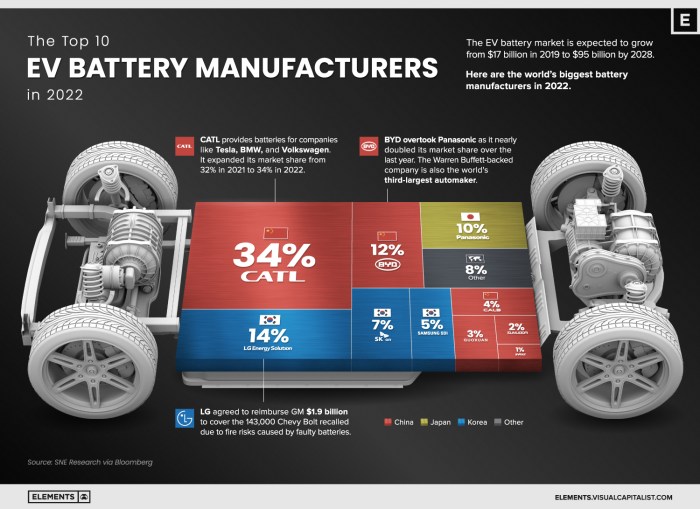Apple’s Supply Chain Dynamics
Apple’s supply chain is a marvel of intricate relationships and strategic management, driving the company’s success in the tech world. The complex web of suppliers, manufacturers, and distributors working in harmony ensures the seamless delivery of Apple products globally. This intricate ecosystem, however, is not without its challenges, particularly when it comes to component pricing.
The intricate relationships between Apple and its suppliers are characterized by a delicate balance of power and interdependence. Apple, with its immense brand power and market dominance, exerts significant influence on its suppliers. Conversely, suppliers rely on Apple for substantial revenue and access to cutting-edge technology. This interdependence fosters a dynamic negotiation landscape, where both parties strive for favorable terms.
Historical Trends of Component Pricing
Component pricing in Apple’s supply chain has been a subject of constant negotiation and fluctuation over the years. Historically, component prices have generally trended downwards, driven by factors like technological advancements, increased competition, and economies of scale. This downward trend has been particularly evident in components like memory, processors, and displays. However, recent years have witnessed a shift in this trend, with component prices experiencing upward pressure due to global supply chain disruptions, rising material costs, and increased demand.
Apple’s Negotiation Strategies
Apple’s negotiation strategies with suppliers are a testament to the company’s meticulous planning and strategic acumen. The company leverages its massive purchasing power to secure favorable pricing for components. Apple also employs a multi-pronged approach to negotiations, encompassing factors like:
- Long-term contracts: Apple frequently enters into long-term contracts with its key suppliers, ensuring stable supply and potentially securing lower prices. These contracts often involve volume commitments, which benefit both parties by providing predictability and economies of scale.
- Competitive bidding: Apple encourages competition among its suppliers, driving down prices through competitive bidding processes. This strategy ensures that the company receives the best possible deals on components.
- Vertical integration: In certain instances, Apple has pursued vertical integration, acquiring or investing in companies that manufacture key components. This strategy gives Apple greater control over component costs and supply chains.
- Design optimization: Apple’s engineers constantly strive to optimize product designs, reducing the number of components required and potentially lowering overall costs. This strategy not only reduces component costs but also contributes to product innovation.
Apple’s Financial Performance and Supplier Relationships: Apple Suppliers Not Lowering Component Prices
Apple’s financial performance has been consistently strong in recent years, characterized by high profit margins and a dominant position in the global smartphone market. The company’s profitability is intricately linked to its supplier relationships, and the cost of components plays a crucial role in determining Apple’s pricing strategies.
Apple’s Profit Margins and Financial Performance
Apple’s financial performance is a testament to its ability to command premium pricing for its products. The company’s gross profit margin, which measures the profitability of its products, has consistently remained high, exceeding 30% for several years. This is significantly higher than the average gross profit margin for other technology companies. Apple’s high profit margins are a result of its brand recognition, strong customer loyalty, and effective cost management.
Impact of Component Costs on Apple’s Profitability
The cost of components, particularly those used in Apple’s flagship products like iPhones, iPads, and Macs, is a significant factor in the company’s overall profitability. While Apple has a reputation for using high-quality components, the cost of these components can fluctuate based on factors such as global supply chain dynamics, raw material prices, and technological advancements. Higher component costs can impact Apple’s profit margins, especially if the company is unable to pass on these costs to consumers through price increases.
Apple’s Pricing Strategies and Component Costs
Apple’s pricing strategies are heavily influenced by the cost of components. The company aims to balance its desire for high profit margins with the need to remain competitive in the market. When component costs rise, Apple may choose to absorb some of the increased costs to maintain its pricing strategy. However, in situations where component costs rise significantly, Apple may be forced to increase product prices to protect its profit margins. The company’s pricing decisions are also influenced by factors such as product differentiation, brand positioning, and consumer demand.
Potential Implications for Apple and its Suppliers
The refusal of Apple’s suppliers to lower component prices presents a complex scenario with potential consequences for both parties. While Apple may face pressure on its profit margins and competitiveness, suppliers could risk losing a significant customer and facing challenges in securing future contracts.
Impact on Apple’s Product Pricing and Competitiveness
The decision by Apple’s suppliers to maintain component prices could directly impact Apple’s ability to keep its product prices competitive. This could lead to several potential consequences:
- Increased Product Costs: Higher component prices directly translate into higher manufacturing costs for Apple, which could necessitate an increase in product prices. This could make Apple’s devices less attractive to consumers, particularly in a price-sensitive market.
- Reduced Profit Margins: If Apple is unable to pass on increased component costs to consumers, its profit margins could be squeezed. This could impact Apple’s ability to invest in research and development, marketing, and other areas crucial for its long-term growth.
- Competitive Disadvantage: If competitors are able to secure components at lower prices, they could offer similar products at more competitive prices, potentially eroding Apple’s market share. This could create pressure on Apple to lower its prices, further impacting its profitability.
Alternative Sourcing Strategies for Apple
Apple could explore alternative sourcing strategies to mitigate the impact of high component prices:
- Negotiation and Collaboration: Apple could engage in further negotiations with its existing suppliers, potentially exploring volume discounts or other cost-saving measures. This could involve collaborative efforts to optimize production processes and reduce waste.
- Diversification of Suppliers: Apple could diversify its supplier base, exploring partnerships with alternative component manufacturers. This could create more leverage in negotiations and potentially secure more competitive pricing.
- Vertical Integration: In some cases, Apple could consider vertical integration, acquiring or investing in component manufacturers to gain greater control over production costs. This strategy, however, can be complex and resource-intensive.
Industry Perspectives and Expert Opinions
The decision by Apple’s suppliers to maintain component prices has sparked diverse reactions and opinions within the tech industry. Industry analysts and experts offer varying perspectives on the implications of this move for Apple, its suppliers, and the broader tech ecosystem. This section delves into the key opinions and arguments expressed by prominent figures in the tech industry.
Comparison of Perspectives
The issue of component pricing has elicited a range of viewpoints from different stakeholders involved in the Apple supply chain.
- Apple’s Perspective: Apple, as the dominant player in the smartphone market, is likely to prioritize maintaining its profit margins and product quality. While component price increases may impact their bottom line, Apple is expected to negotiate aggressively with suppliers to secure favorable pricing terms. Apple might also explore alternative sourcing options to mitigate potential price hikes.
- Supplier Perspective: Suppliers, on the other hand, are facing rising costs due to factors such as global supply chain disruptions, increased material prices, and labor shortages. Maintaining or increasing component prices allows them to protect their profit margins and continue investing in research and development.
- Consumer Perspective: Consumers are likely to be impacted by higher component prices, potentially leading to higher product prices. However, the demand for Apple products remains strong, and consumers may be willing to pay a premium for the brand’s reputation for quality and innovation.
- Industry Analyst Perspective: Industry analysts are closely monitoring the situation and analyzing the potential impact on Apple’s financial performance, its competitive landscape, and the broader tech industry. Some analysts argue that Apple’s strong brand loyalty and pricing power will allow it to absorb higher component costs without significantly impacting sales. Others suggest that Apple may need to explore alternative strategies to maintain its competitive edge, such as reducing product features or exploring lower-cost components.
Key Opinions and Arguments, Apple suppliers not lowering component prices
| Expert | Opinion/Argument | Source |
|---|---|---|
| Dan Ives, Wedbush Securities | “Apple’s pricing power is strong, and we believe they can pass on some of the cost increases to consumers. However, if component prices continue to rise, Apple may need to explore alternative sourcing options or adjust product features to maintain profitability.” | Wedbush Securities Research Report, 2023 |
| Gene Munster, Loup Ventures | “The current supply chain disruptions are creating a challenging environment for Apple and its suppliers. However, we believe Apple’s strong brand and loyal customer base will help them weather this storm.” | Loup Ventures Research Report, 2023 |
| Tim Cook, CEO of Apple | “We are closely monitoring the global supply chain and working with our suppliers to mitigate the impact of rising component prices. We are confident that we can navigate these challenges and continue to deliver innovative products to our customers.” | Apple Earnings Call Transcript, 2023 |
Apple suppliers not lowering component prices – The saga of Apple’s component pricing is a story of intricate relationships, economic pressures, and technological innovation. It’s a narrative that’s far from over, with potential implications that could reshape the tech landscape. Whether Apple can navigate these challenges and maintain its competitive edge remains to be seen. The coming months and years will likely witness a continued struggle for dominance as Apple and its suppliers grapple with the ever-changing dynamics of the global tech market. Stay tuned for updates as this story unfolds.
Apple’s suppliers are sticking to their guns, refusing to budge on component prices, even as the tech giant grapples with slowing iPhone sales. This stubborn stance might be a recipe for trouble, especially with new players like HTC looking to disrupt the market. With the HTC Desire 10 Pro Lifestyle in the works , HTC could be poised to capitalize on the price-sensitive consumer market, putting further pressure on Apple to reconsider its pricing strategy.
Ultimately, it’s a gamble for both sides – will Apple’s brand power be enough to overcome the rising cost of components, or will we see a shift in the mobile landscape?
 Standi Techno News
Standi Techno News

